Landscape photography is the art of taking images of the outdoors and natural environments. The best photographs capture the subject's spirit and reveal the photographer's connection to nature, whether intimate details or expansive landscapes.
In today’s era, where sustainability and adventure meet, the need for reliable power sources for photography has become crucial. For this reason, the Jackery Solar Generators stand out as one of the eco-friendly and portable power solutions. They provide the essential power backup needed to charge shooting gear outdoors.
What Is Landscape Photography?
Landscape photography captures the essence of the natural world. It conveys the feeling of being present to witness something unique. The French inventor Nicéphore Niépce captured the first known image of a landscape in an urban setting in 1826 or 1827. Then, in 1935, English scientist Henry Fox Talbot made several photographic innovations possible. The reasons behind each landscape photographer's decision to pursue this genre vary. Many are passionate about photographing landscapes for different reasons and are united by the same.
Landscape Photography Equipment & Accessories
Choosing the appropriate landscape photography equipment can be demanding whether you're a novice, an enthusiast, or a seasoned pro. Thousands of accessories, cameras, and lenses are available, so picking the right gear can improve your pictures.
Here’s a list of equipment and accessories that are needed for Landscape photography :
- Backpack
- Weather-sealed camera
- Tripod
- Lenses
- Strong Network
- Nice pair of shoes
- ND filter
- UV Filter
- Batteries
A dependable green energy source for outdoor activities and photography, the Jackery Solar Generators are compatible with outdoor use. Its portability makes it an ideal option for landscape photographers, enabling them to charge their gear at any location during the golden hours. Thanks to charging capabilities, you won't have to worry about your cameras running out of battery power when clicking landscapes in isolated locations.
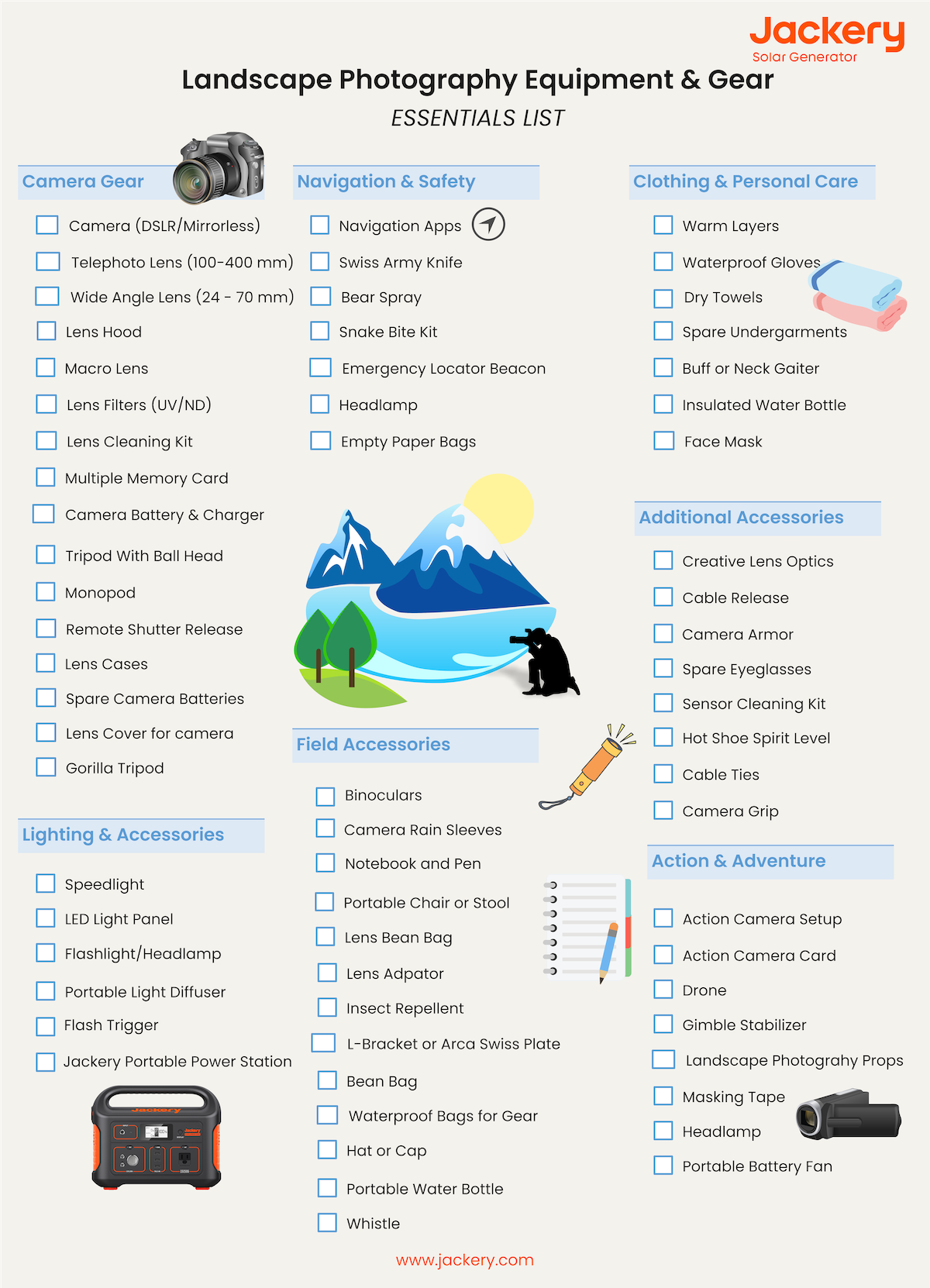
Packaging the appropriate items in your bag is just as important as considering factors like the weather and backup destinations. Whether traveling light or heavy, carrying the essential equipment will help you capture the shots you were hoping for and make the entire experience much more pleasurable. A checklist helps you get the most out of your landscape exploration.
Camera Settings for Landscape Photography
You must use the proper camera settings to capture a landscape's natural beauty. As with all photographic genres, there is much variation in how we photograph landscapes and what camera settings we employ. The lighting and wide angle of the shot present the biggest challenges for landscape photographers. Here are some tips to assist with camera setup :
Start with RAW
Always shoot in RAW first. If you're not shooting in RAW, you're losing out on important information from your shots and having fewer post-production options. This holds for whatever you're taking pictures of.
Exposure
The histogram holds the secret to taking excellent exposures in landscape photography. The histogram provides everything you need to know about the light reaching the sensor on your camera. You can determine whether or not you will be able to capture the full dynamic range of light in one exposure by examining the histogram.
Aperture
Your aperture affects several aspects of the picture, making it a crucial camera setting for landscape photography. First, it impacts depth-of-field (DOF), determining the focus of your image. Second, by regulating the light that passes through when it opens and closes, your aperture influences your exposure. Lastly, your aperture can impact sharpness. These factors are necessary to produce sharp, well-exposed, and focused landscape photographs.
Shutter Speed
Shutter speed is typically secondary in landscape photography because the aperture is the most crucial camera setting. It is only essential if there are moving subjects, such as people, clouds, or water.
White Balance
White balance is easily adjustable in post-production. You should use one of your camera's WB presets to provide a better starting point when uploading your pictures.
Landscape Photography Tips & Techniques
Today, most of us carry cameras wherever we go, and we love landscape photos. Landscape photography requires some planning in terms of location and equipment selection. If traveling specifically to photograph landscapes, learn everything about the destination. You might come across some beautiful views.
Here are some landscape photography tips that will prepare you for landscape photography :
Research Location
Before you leave your house, take a moment to look up online information about any new place you are visiting—research different locations of interest and viewpoints. Google Street View can also give a preview of the area around. This way, you can imagine an ideal shooting landscape and outline some necessary steps.
Perception is Perspective
Human presence gives the viewer another perspective, making the scene more majestic. Visiting the place stimulates interaction between the image and the viewer. You must choose people who wear bright clothes that make them visible from among others in open spaces.
Reflection
Water reflections significantly change pictures. Adding symmetry improves the photograph’s composition. Do not go if it is windy; find calm when the water has no waves. Try to get angles that will cover as much landscape as possible.
Grab a Headlamp
Use your headlamp at night if you want to make it enjoyable by capturing good pictures. Instruct your subject to stay still so the headlamp’s ray looks like a line in a cartoon. Also, depending on your location, an alternative could be using the light on the surroundings or shooting the camera upwards to create an attractive light beam in the sky.
Timing, composition, and skill are essential aspects of landscape photography. The perfect shots are usually planned first. Thus, while taking the ideal shot might require some effort, it is worth it.
These ten advanced tips will help improve your landscape photographs regardless of how much experience you have :
Selecting Aperture
For a sharp image with maximum focus, choose an f-stop number about two to three stops higher than the lowest possible setting to get the best results. When shooting at such apertures as f/2.8 or even f/22, clarity can be disrupted slightly at either end of the measurement scale.
Choosing ISO
You can also maintain a low ISO to ensure the highest-quality images. You can still shoot at your preferred aperture and shutter speed. This helps prevent grainy pictures, sometimes caused by higher ISO settings. An ISO ranging from 100 to 400 usually does well in this case.
Use a Tripod
You may also ascertain the hand-held shutter speed of the lens by checking its focal length and using a tripod for shutter speeds less than one over that number. For example, you can shoot at 1/50th of a second without getting a blurred handshake; however, you must use a tripod below this speed.
Shoot in the Golden Hour
The ideal time to take photos is during the golden hour. As the sun sets, it has soft rays that are less harsh on your subject. The color is more intense, and the contrast is more significant. Light can be widely used to create dramatic moments, making it the best time to be creative with your pictures.
Use a Filter
Many photographers specializing in landscape photography prefer polarizing filters since they help reduce glare, enhance color and contrast, and improve image quality. For instance, landscapes with lots of reflections, water bodies, or sky shots will benefit from using these filters. Most polarizing filters are rotatable by hand; hence they usually get screwed onto the front end of the camera lens to adjust its polarization. It shields your lens glass against scratches and other damages.
Use Wide Angle Lens
Wide-angle lenses are typically the best for landscape photography. Your go-to, high-quality wide-angle lens will be the workhorse for taking landscape photos. Even with small subjects, using your wide-angle lens to get closer to them might be preferable to using a longer lens to zoom in.
Modify Camera Settings
Slow shutter speeds are the only way to achieve low ISO and high f-stop. Remember to use a tripod at low shutter speeds to prevent blurry photos. All photographers can significantly benefit from using their camera's histogram display. When appropriately used, this informative display can inform you whether the blacks are underexposed or the bright whites are clipped.
Compose a Landscape Photo
Applying the rule of thirds can easily create a balanced and eye-catching image. To do this, use imaginary grid lines to divide your image into vertical and horizontal thirds, then place your subject along the lines or at the intersection of two lines. Using lines is one of the most effective ways to focus the viewer's attention on your main subject and convey movement in your photograph.
Find your Focus
By changing your focus, you can give your photos a slight variation. You can get a bird's eye view by jumping up on a rock, concentrating on the foreground, and putting your camera or smartphone on the ground to create a low-angle frame.
Use RAW Format
Even though saving as a JPEG directly from the camera might seem more manageable, you will lose important information that you may need to use in post-processing. Developing a solid workflow with RAW files can be very beneficial, allowing for more accurate color balance adjustments and exposure details.
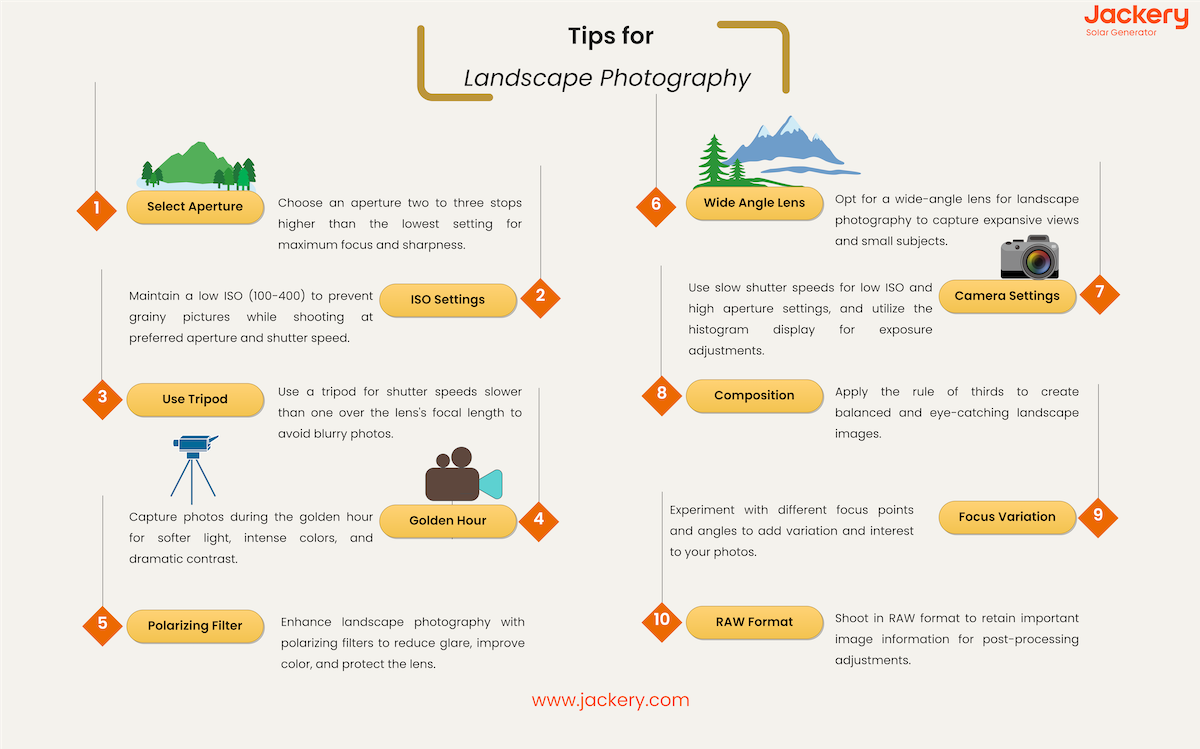
More Photography Tips for Different Landscapes
Photography at the beach, in winter, at sunsets, or with water droplets in puddles demands a little more preparation than other types of photography. Discover how to take the ideal picture in any weather with these tips.
Rain Photography Tips
When taking pictures in the rain, you can prefer a large golf-style umbrella over standard, more miniature umbrellas. Hand-holding is much more effective than it used to be and can result in very sharp images because most mirrorless cameras and lenses come equipped with optical or image sensor stabilization.
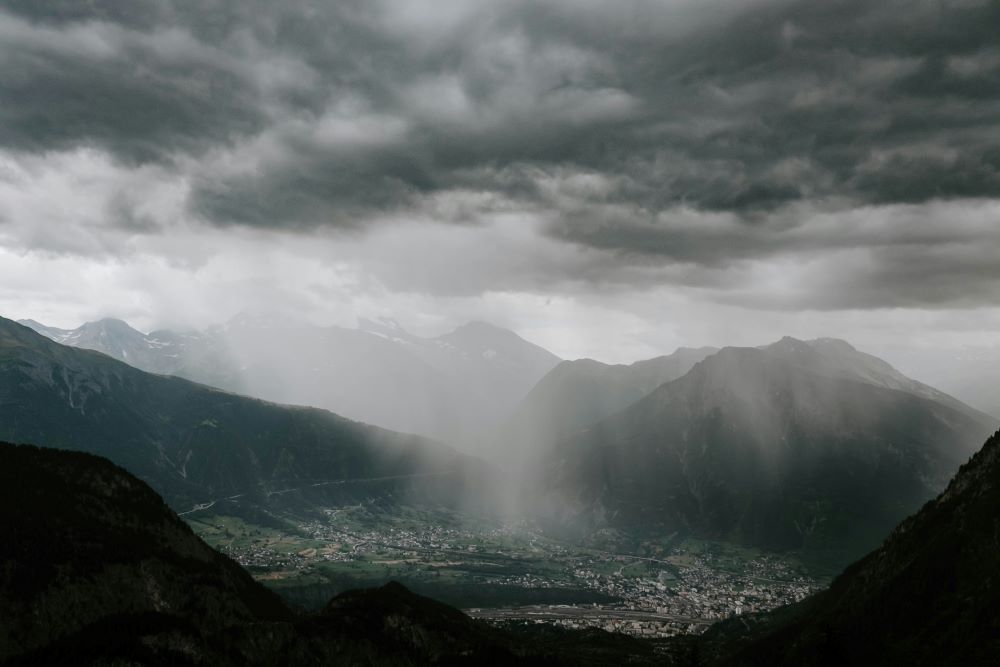
Ocean Photography Tips
Use a rain cover to keep out moisture and mist. Ensure your camera bag is watertight, and keep it sealed when you're not actively taking items out of it. The ocean is erratic, so plan because a rogue wave could wash your camera away, even if you believe you are far enough from the water.
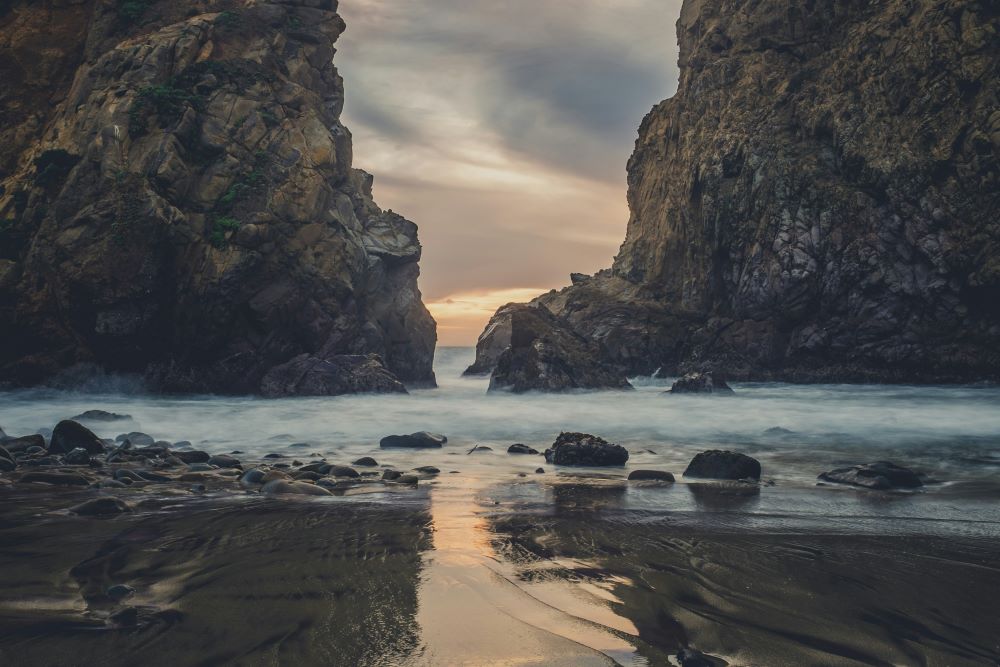
Beach Photography Tips
Your beach photos will be more enjoyable with the clouds. The most typical foregrounds at the beach are rocks, sand, and water patterns. However, they might only be sufficient to constitute a compelling subject if the patterns in the sand and water contain some particularly intriguing details. Thus, instead of merely pointing and shooting towards the ocean, actively search for the most captivating foregrounds.
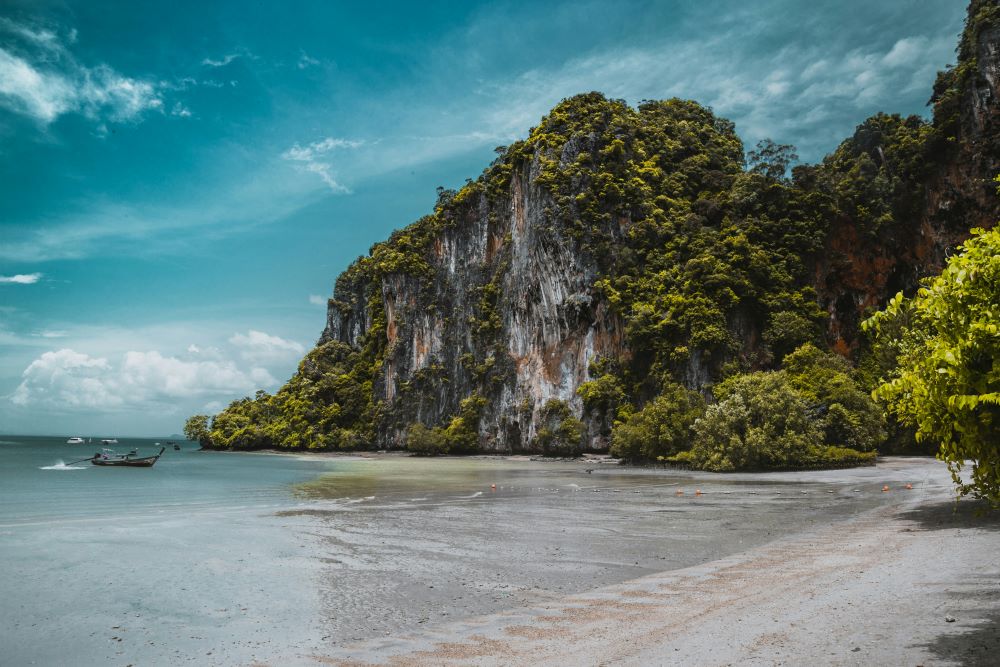
Winter Photography Tips
Be mindful of the temperature, air humidity, and wind speed, as the latter can significantly reduce the perceived temperature. To capture the best shots, landscape photographers should arrive at their location at least 30 to 45 minutes before sunrise. This is because pink clouds can appear quite early in the morning. However, that is also the time of year when the lowest temperatures occur.

Sunset Photography Tips
Take caution when taking pictures of the sun! Prolonged exposure to direct sunlight, even when using a rangefinder, can harm your retina and, in severe situations, your camera's sensor. Composing your shot using your camera's LCD screen is a safer option, but only use it for as long as necessary.
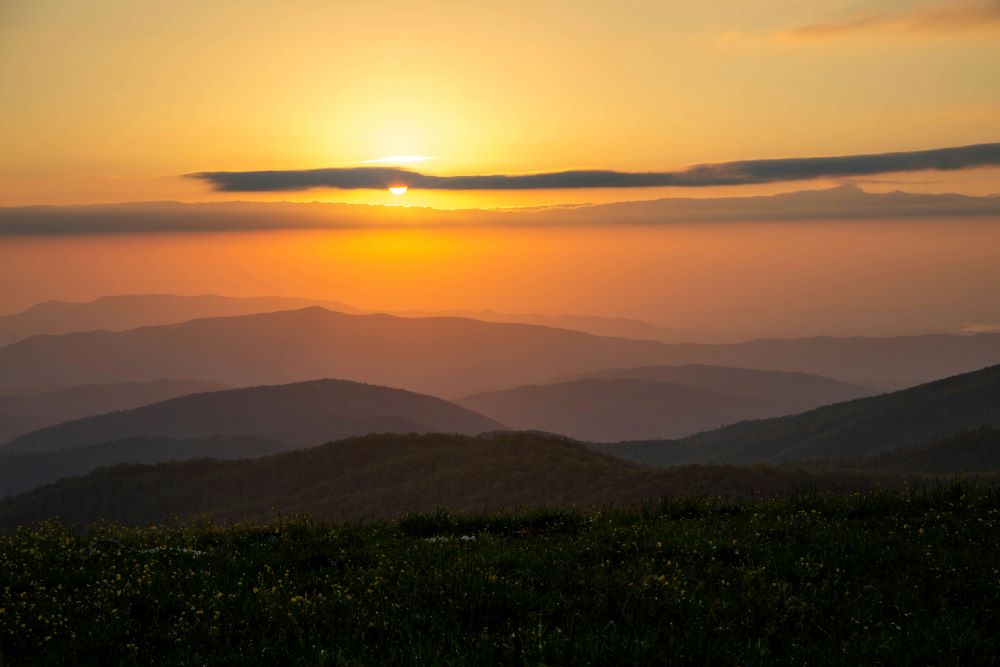
How do Jackery Solar Generators Help with Landscape Photography?
Jackery is a global leader in producing outdoor portable power stations, solar generators, and solar panels. These are designed for outdoor activities and provide a sustainable and environmentally friendly solution for charging appliances and acting as an emergency backup.
The Jackery Solar Generator is a solar power system with a Jackery Explorer Portable Power Station and Jackery SolarSaga Solar Panels. It emits no toxic gas and operates cleanly, causing no environmental harm. Jackery Solar Generators offer a green energy source for photography and outdoor activities. Due to its portability, it becomes a perfect choice for landscape photographers, as it helps them charge their devices anywhere during the golden hours.
The Jackery Solar Generators have a reduced noise level, ensuring minimal disturbance in tranquil landscapes. This makes them compatible with landscape photography. Due to their portability, you can also bring them along on your outdoor adventures. While exploring remote areas for landscape photography, you can charge your cameras without worrying about running out of battery.
Jackery Solar Generator 500
You may need to use the camera continuously and charge the equipment during breaks. The Jackery Solar Generator 500 is an excellent choice to meet these power requirements. It has a capacity of 518 Wh, making it an efficient portable power source. Jackery Solar Generators are safe, reliable, and simple, making them ideal for your favorite outdoor adventure or planned on-location photo shoot.
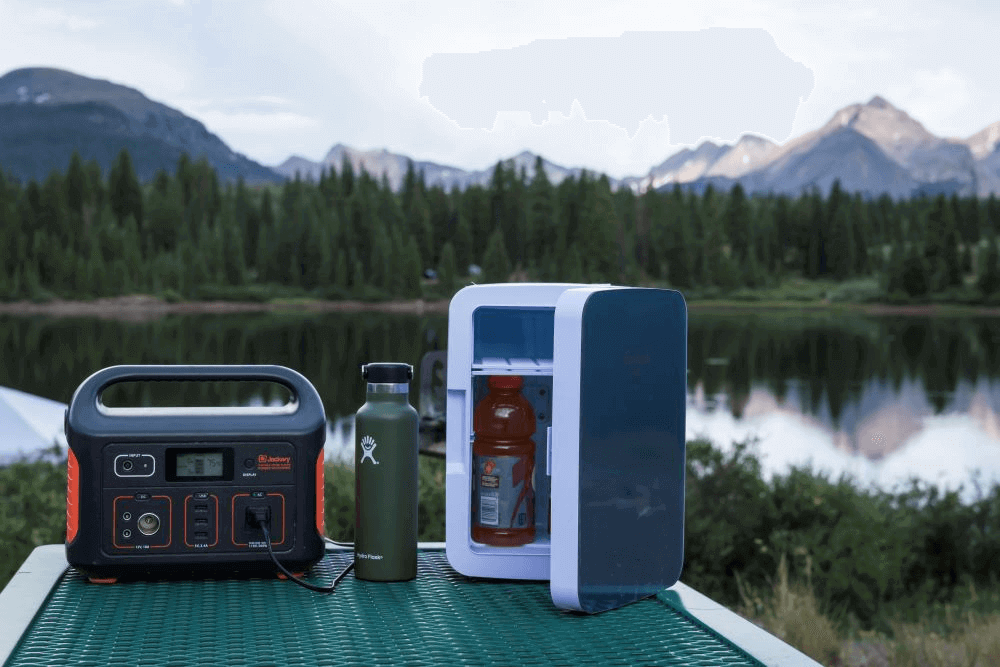
Customer Review
“I began to consider the potential for photographers who need remote power to recharge their cameras, laptops, phones, or accessories. I said “yes” to some of Jackery's products. My first impressions of the Jackery products were positive. The materials seem tough and durable.” — Dustin Abbott.
Jackery Solar Generator 1000 Plus
Jackery Solar Generators are portable, clean power supplies that are becoming increasingly popular among the photography community. The Jackery Solar Generator 1000 Plus, with a capacity of 1264 Wh, provides photographers with green, quiet, and convenient outdoor power solutions. This model can charge devices with higher power and longer charge times, significantly improving outdoor photography experiences.
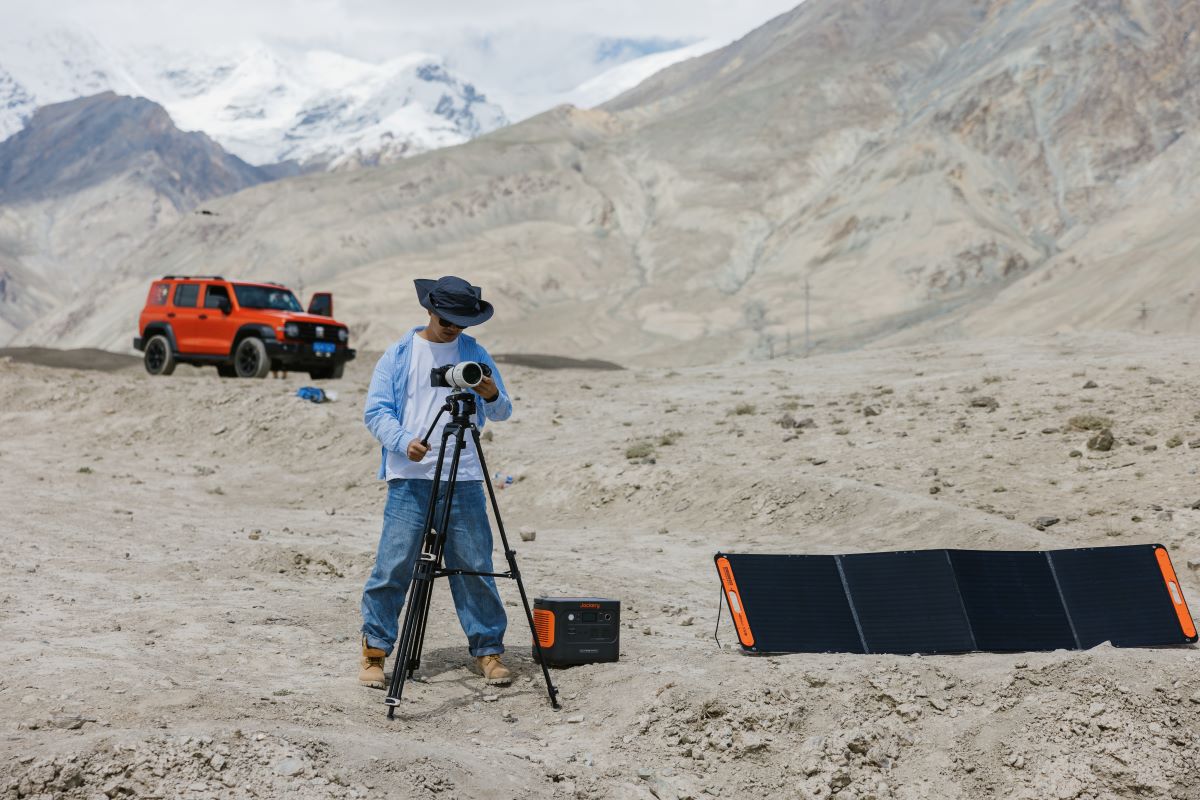
Customer Review
“The Solar Generator 1000 easily has enough capacity to keep laptops and cameras topped up with free solar energy. ” –- Adam Waring.
|
|
Solar Generator 500 |
Solar Generator 1000 Plus |
|
Capacity |
518 Wh |
1264 Wh |
|
Battery Cell |
NMC |
LiFePO4 |
|
Cycle Life |
500 cycles to 80% + capacity |
4000 cycles to 70% + capacity |
|
Recharging Methods |
Solar Recharging : 9.5 H (1 * SolarSaga 100W Panels) |
Solar Recharging : 2 H (6* SolarSaga 200W solar panels) Wall Recharging : 1.7 H Car Recharging : 7 H |
|
Output Ports |
USB-A Output : 5 V⎓2.4 A USB-C Output : 5 V⎓3 A AC Output (x1) : 110 V, 60 Hz, 500 W (1000 W Peak) DC Output (x2) : 12 V⎓7A USB-A Output (x3) : 5 V⎓2.4 A |
AC Output (x3) : 120 V~60 Hz, 2000 W (4000 W Peak) USB-A Output (x2) : 18 W Max, 5-5 V⎓3 A USB-C Output (x2) : 100 W Max, (5 V, 9 V, 12 V, 15 V, 20 V up to 5 A) USB-C Output : 5 V⎓3 A |
|
Working Hours |
DSLR (30 W) : 14.6 H |
DSLR (30 W) : 35.8 H |
Landscape Photography FAQs
What size of power station do I need for photography?
Investing in solar generators is one way to switch to clean, renewable energy while charging electronics. However, the exact size of the solar generator required to charge most home appliances will depend on how many devices you use and how long you want to power them.
For example, a Jackery Explorer 500 Portable Power Station can charge a mirrorless camera (45 W) and a DSLR (60 W).
Working Time = Capacity in Wh × 0.85 / Operating wattage of the appliances.
So, Working time = 518 Wh × 0.85 / 105 W = 4.2 H.
As there will be some power loss while charging the appliances, we multiply the battery capacity by 0.85.
Who are the best landscape photographers?
Sean Bagshaw, Kai Homung, Marco Grassi, etc., are some of the best landscape photographers.
What are the four pillars of landscape photography?
Light, composition, sharpness, and exposure are the four pillars of landscape photography.
Why is landscape photography hard?
Landscape photography is a difficult genre that requires a high level of skill. It is among the most challenging landscapes to capture on camera because it frequently needs a clear focal point.
What is the golden rule of landscape photography?
Pictures should contain interesting elements on those lines or at their intersections. Another rule, the golden mean, uses the diagonal to produce dynamic images where the subjects are positioned in visually appealing settings.
Final Thoughts
Landscape photography is a captivating art form that captures the splendor and soul of our natural surroundings. For photographers, Jackery Solar Generators are compatible solutions that provide green and handy power for prolonged charging of outdoor appliances. With their reduced noise levels and highly portable nature, Jackery Solar Generators make landscape shots more potent by removing any breaks in the electricity supply, resulting in unforgettable experiences outdoors.
Learning Resources
- The Landscape Photography Book by Scott Kelby
- Book on Essential Guide to Landscape Photography 7 by Daniel Lezano
- Landscape Photography Tips | A Beginners Guide
- The Ultimate Guide to Landscape Photography
- Landscape Photography Tips





















































































































Leave a comment